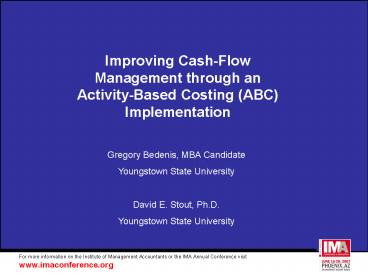Improving CashFlow Management through an ActivityBased Costing ABC Implementation - PowerPoint PPT Presentation
1 / 24
Title:
Improving CashFlow Management through an ActivityBased Costing ABC Implementation
Description:
Improving Cash-Flow Management through an Activity-Based Costing (ABC) ... Overhead costs are assigned using a two-step process: Costs are assigned to activities ... – PowerPoint PPT presentation
Number of Views:70
Avg rating:3.0/5.0
Title: Improving CashFlow Management through an ActivityBased Costing ABC Implementation
1
Improving Cash-Flow Management through an
Activity-Based Costing (ABC) Implementation
Gregory Bedenis, MBA Candidate Youngstown State
University David E. Stout, Ph.D. Youngstown
State University
2
XYZ Corporation
Designer and Manufacturer of Value-Based Consumer
Electronics
- Established in 1999
- One manufacturing facility
- Distribution channels
- Domestic internet direct
- Foreign dealer network
- 9 million in annual sales
- 13 employees
3
Competitive Environment
- The Competition
- Low-cost, internet-direct distributors
- - Purchase items complete from China
- High-end manufacturers
- - Established brand names
- - Distribute products in specialty stores
- The XYZ Company
- High-value products
- - Low overhead costs
- Superior customer service
4
XYZs Historical Performance
- 40 annual sales volume and revenue growth
- Three product families
- Inventory turns of approximately 4
- Low overhead costs
- High dividend payouts
- Low of days payable outstanding
5
XYZs Recent Performance
- 20 sales volume and revenue increase
- Six product families
- Decreasing inventory turns ( 2.5)
- Increasing overhead costs
- Decreased dividend payouts
- Increasing days payable outstanding
6
Summary Problem Cash Flow
7
(No Transcript)
8
Performance Drivers
- Increased product-line diversity (to promote
increased sales revenue) - Lack of spending controls regarding overhead
costs - Poor inventory management
- Inefficient business processes
- Nonexistent product-costing system
9
Solution
- Introduce a rudimentary Activity-Based Costing
(ABC) system to - Capture underlying economics of the companys
production function - Improve product-mix decisions
- Improve product and/or customer costing
- Evaluate product-level and customer-level return
on investment (ROI) - S IMPROVED CASH FLOW
10
(No Transcript)
11
ABC Elements
- Resources Economic elements
- Activities Units of work
- Resource Drivers Used to assign costs from
resources to activities. - Cost Objects Final cost-allocation point (e.g.,
products, services) - Activity Cost Drivers Used to assign costs of
activities to cost objects.
12
General Representation ABC Model
Resources
Activity Center
Resource Driver
Activities and Activity Cost Pools
Cost Element
Activity Driver
Cost Objects
13
ABC Underlying Principles
- DM and DL traced to individual products
- Overhead costs are assigned using a two-step
process - Costs are assigned to activities
- Activities are assigned to products
- ABC reflects product/customer diversity and
complexity - ABC concepts can be extended to encompass
allocation of assets, namely inventory
14
Cost Objects at XYZ Corporation Product
Families or Distribution Channels
- A Accessories
- T Durable Textured Black Finished products
- W Premium Wood Finished products
- V Economical Vinyl Finished products
- U Uniquely Designed products
- S Purchased Complete products
- D Domestic customers
- F Foreign dealers
15
(No Transcript)
16
Financial Improvements at XYZ Based on ABC
Implementation
- Use of common components
- Toyota saves an estimated 1,000 per vehicle over
5 years by using common components - XYZ estimates a 132,000 reduction in inventory
by implementing the use of common components in
the following product lines - T (Durable Textured Black products)
- V (Economical Vinyl Finished products)
- F (Foreign dealers)
17
Use of Common Components at XYZ
18
Additional Financial Improvements
- Product-Mix Decisions
- ROI and cash flow can be increased by product-mix
decisions - 75,000 inventory reduction by implementing
the following product-mix changes - Eliminate off-color finishes in (V) Vinyl and (S)
Purchased Complete product families - Eliminate maple wood in (W) Premium Wood Finished
product family - Increasing sales in the uniquely designed product
family (U) should increase ROI and cash flow
19
Product-Mix Decisions at XYZ
20
Business Process Improvements at XYZ
- Restructuring of the General Ledger
- Restructuring of the Profit and Loss (PL)
Statement - Integration of inventory control system with
financial system - Integration of the internet shopping cart with
the financial system - Implementation of a budgeting process
21
Overall Improvements at XYZ
- Inventory reduction 207,000
- ROI increase 27
- Parts proliferation decreased Eliminated 69 of
the electronic component part numbers - Integration of important information systems
- Creation of understandable financial statements
- Made company more data-literate
22
Overall Financial Improvement at XYZ
23
Lessons Learned from ABC Implementation Effort at
XYZ
- Manage the implementation timeline by managing
the access and flow of information. - Embrace the concept of good enough when
determining the required fineness of the cost
data. - Focus on getting the project off the ground.
- Significant change doesnt occur without crisis,
so be ready for the next crisis.
24
(No Transcript)































